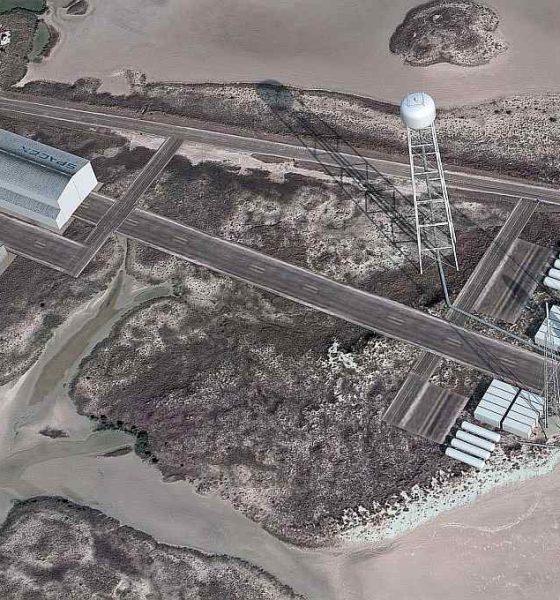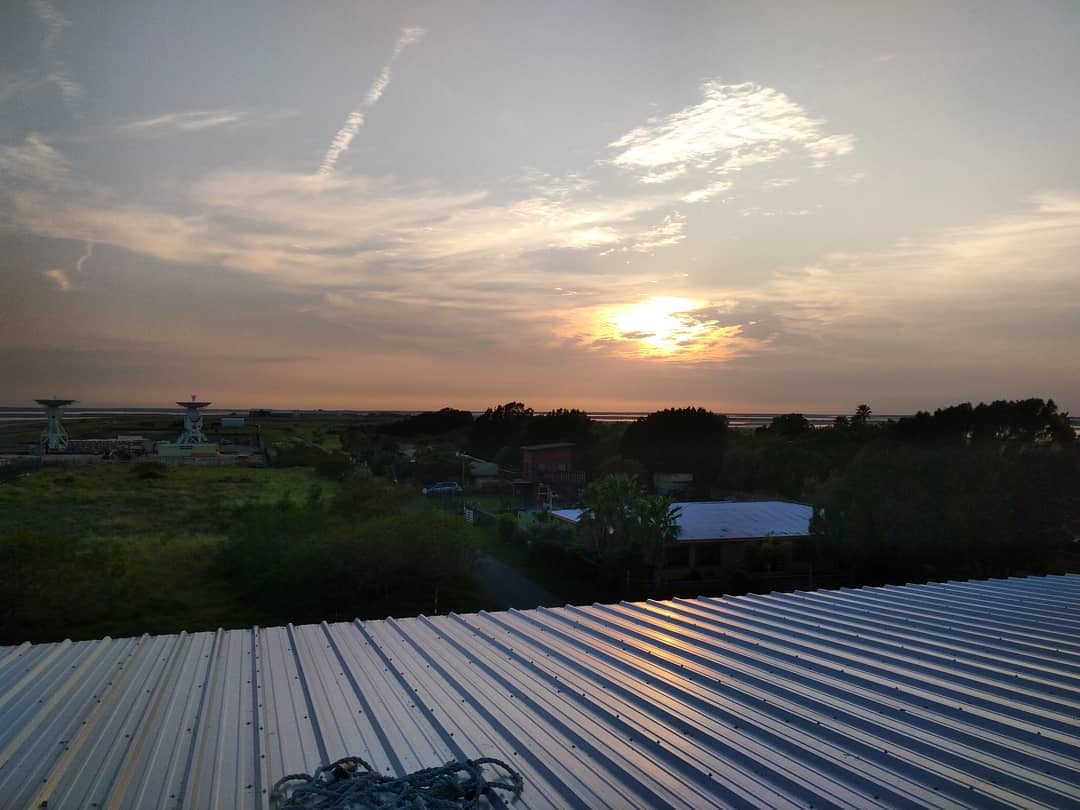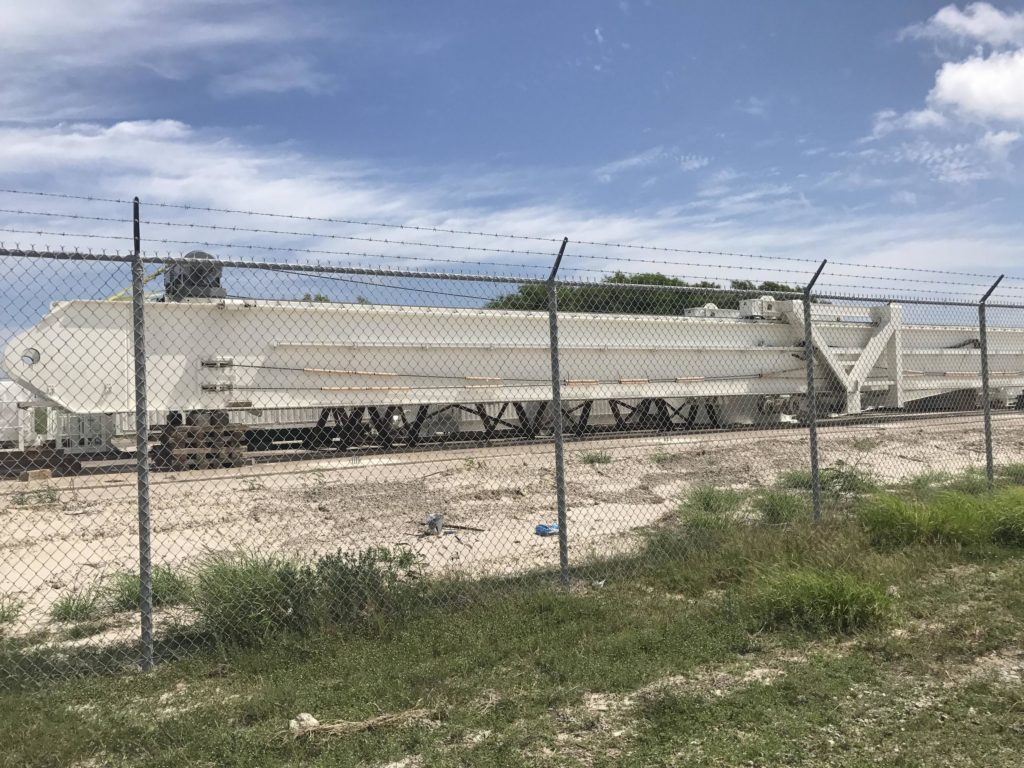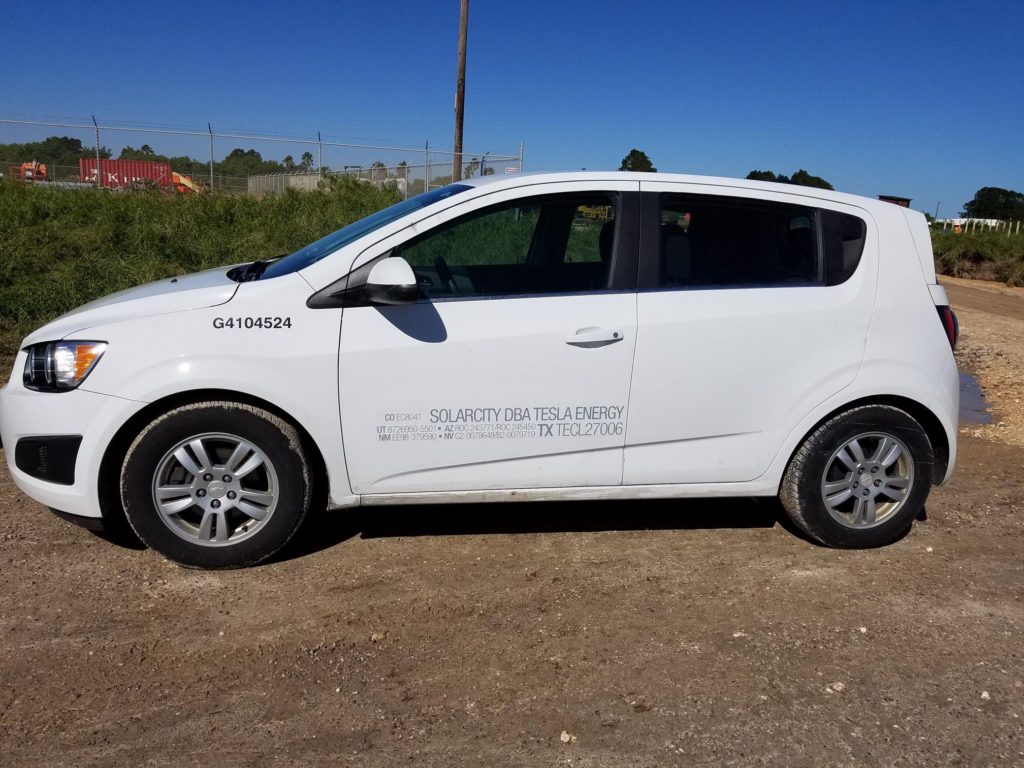

News
SpaceX could begin testing its Mars rocket in Texas by late 2018, early 2019
On the heels of a successful wet dress rehearsal for Falcon Heavy, SpaceX’s President and COO Gwynne Shotwell spoke briefly about SpaceX for an aerospace conference located at Texas’ Academy of Medicine, Engineering & Science. Ars Technica’s senior spaceflight editor Eric Berger was in attendance and provided a rough outline of live tweets during the first group of presentations.
While the phrasing cannot provide absolute confirmation, Berger summarized a statement by Shotwell suggesting that SpaceX’s Boca Chica, Texas launch site, currently in the early stages of construction, could be ready to host “vehicle tests” as soon as late 2018, early 2019. At this point in time, based on comments from Shotwell and CEO Elon Musk, it can be reasonably assumed that SpaceX’s Texas launch facilities will be dedicated mainly to the company’s interplanetary colonization efforts, and will probably be tailored to support the testing and eventual launches of BFR/BFS.
Some news from Shotwell: Brownsville launch site ready for vehicle tests in late 2018, early 2019. Move to launch site after that.
— Eric Berger (@SciGuySpace) January 11, 2018
After nine months of earnest construction and rehabilitation, SpaceX’s LC-40 pad was recently reactivated and has since supported two launches without any major hitches. At the same time, LC-39A in flux in order to support launches of SpaceX’s new Falcon Heavy rocket, the size of which required some concomitant upgrades to multiple ground systems. With both of those major tasks now effectively complete, SpaceX’s pad construction team is free to either refocus their efforts towards Boca Chica. Over the past several months, Boca Chica has seen a gradual but consistent level of development, mainly by way of unaffiliated SpaceX contractors. These changes have been dutifully tracked over the last several years on NASASpaceflight.com forums by a handful of friendly local residents interested in the changes coming to Boca Chica and Brownsville, Texas, a nearby town.

SpaceX’s Boca Chica facilities and STARGATE dishes (center-left) seen at sunset from the top of the giant crane garage. (anonymous Instagram user)
Most significantly, the last several months have seen three major developments. First and most prominently, a permanent facility called STARGATE externally appears complete and its two large radio communication dishes have been installed nearby. The STARGATE facility is a public-private partnership between the University of Texas at Brownsville (now part of University of Texas Rio Grande Valley) and SpaceX, with the academic components focusing on research that SpaceX undoubtedly has interest in: improved orbital spacecraft tracking and communications. Operationally, SpaceX will use the facilities to communicate with and operate its Crew Dragon spacecraft during launches, set to begin with an uncrewed demonstration mission as early as August 2018.
Second, an absolutely massive trolley crane appeared on SpaceX’s land and was eventually housed in an apparently purpose-built shed. The crane dwarfs anything currently used at SpaceX’s launch facilities and is almost certainly a custom-ordered piece of equipment, and thus would be both expensive and explicitly purposeful. What that purpose might be is currently unknown, but it is entirely plausible that the crane is intended to support initial testing (or even limited manufacturing) of SpaceX’s first BFS prototype rockets. This speculation has now been strengthened by Shotwell’s January 11 2018 comment on potential “vehicle tests” occurring at the site within a year or so, and also meshes with a presentation she gave in October 2017 at MIT. It also fits with Elon Musk’s 2017 IAC comments that BFR construction tooling and facilities were respectively already ordered and under construction.

The boom of the giant crane seen in late 2017, parked at SpaceX’s Boca Chica facilities. (Reddit /u/ ticklestuff)
Third and last, the aforementioned SpaceX-following locals observed the early stages of a solar power install beginning on some of SpaceX’s Boca Chica land in late 2017, and also noted that at least some of its contractors were part of Tesla Solar. Plans and permits for solar power were acknowledged as far back as 2014, although at that point the contractor was Solar City (now a part of Tesla). A handful of months later, NASASpaceflight user and all-around awesome guy Nomadd has installed a webcam on a tall pole with a wonderful view of both the solar installation (now nearly completed) and STARGATE. The acre of solar panels can be expected to produce as much as half a megawatt (MW) at peak sun, likely more than enough to offset a considerable amount of the facilities’ electricity usage even after it begins to be see serious use.
- A Tesla Energy/Solar City contractor’s vehicle spotted at the Boca Chica solar installation. (NSF /u/ bocachicagal)
- As of last week, the solar installation appears to be nearly complete. (NSF /u/ Nomadd)
Originally announced as an additional Falcon launch facility in 2014, Boca Chica has remained relatively dormant over the last three years, and it is truly exciting to see activity ramping up. There are admittedly significant barriers that will prevent SpaceX from effortlessly repurposing its Boca Chica pad for BFR, a much larger rocket. If SpaceX intends to do that, they will almost certainly need to pass a significantly updated FAA environmental impact review and account for any remediations that might be required. Still, that is a small ask for for Brownsville’s local government and Texas as a whole, both of which have clearly enjoyed and begun to benefit from SpaceX’s presence in the otherwise unknown area. SpaceX is unlikely to give up on Boca Chica in the near term, so long as Ms. Shotwell maintains her belief that it is effectively the perfect location for BFR launches.
Overall, Shotwell’s comments over the last several months and today in particular are increasingly encouraging, and things are likely to only speed up as 2018 progresses, allowing SpaceX to focus more and more of its expertise on BFR, BFS, and its South Texas testing and launch facilities.
Full disclosure: As Shotwell did not specify which vehicle or vehicles could be expected to begin testing in 2018/2019, it is possible that Falcon 9, not BFR, was the statement’s target. This article should be taken with a grain of salt, as it is educated speculation based upon public information from SpaceX executives and Texas contractors. Teslarati reached out to SpaceX for additional information, but the company was unable to comment further on Shotwell’s presentation at the moment.

Elon Musk
Elon Musk’s X will start using a Tesla-like software update strategy
The initiative seems designed to accelerate updates to the social media platform, while maintaining maximum transparency.

Elon Musk’s social media platform X will adopt a Tesla-esque approach to software updates for its algorithm.
The initiative seems designed to accelerate updates to the social media platform, while maintaining maximum transparency.
X’s updates to its updates
As per Musk in a post on X, the social media company will be making a new algorithm to determine what organic and advertising posts are recommended to users. These updates would then be repeated every four weeks.
“We will make the new 𝕏 algorithm, including all code used to determine what organic and advertising posts are recommended to users, open source in 7 days. This will be repeated every 4 weeks, with comprehensive developer notes, to help you understand what changed,” Musk wrote in his post.
The initiative somewhat mirrors Tesla’s over-the-air update model, where vehicle software is regularly refined and pushed to users with detailed release notes. This should allow users to better understand the details of X’s every update and foster a healthy feedback loop for the social media platform.
xAI and X
X, formerly Twitter, has been acquired by Elon Musk’s artificial intelligence startup, xAI last year. Since then, xAI has seen a rapid rise in valuation. Following the company’s the company’s upsized $20 billion Series E funding round, estimates now suggest that xAI is worth tens about $230 to $235 billion. That’s several times larger than Tesla when Elon Musk received his controversial 2018 CEO Performance Award.
As per xAI, the Series E funding round attracted a diverse group of investors, including Valor Equity Partners, Stepstone Group, Fidelity Management & Research Company, Qatar Investment Authority, MGX, and Baron Capital Group, among others. Strategic partners NVIDIA and Cisco Investments also continued support for building the world’s largest GPU clusters.
News
Tesla FSD Supervised wins MotorTrend’s Best Driver Assistance Award
The decision marks a notable reversal for the publication from prior years, with judges citing major real-world improvements that pushed Tesla’s latest FSD software ahead of every competing ADAS system.

Tesla’s Full Self-Driving (Supervised) system has been named the best driver-assistance technology on the market, earning top honors at the 2026 MotorTrend Best Tech Awards.
The decision marks a notable reversal for the publication from prior years, with judges citing major real-world improvements that pushed Tesla’s latest FSD software ahead of every competing ADAS system. And it wasn’t even close.
MotorTrend reverses course
MotorTrend awarded Tesla FSD (Supervised) its 2026 Best Tech Driver Assistance title after extensive testing of the latest v14 software. The publication acknowledged that it had previously criticized earlier versions of FSD for erratic behavior and near-miss incidents, ultimately favoring rivals such as GM’s Super Cruise in earlier evaluations.
According to MotorTrend, the newest iteration of FSD resolved many of those shortcomings. Testers said v14 showed far smoother behavior in complex urban scenarios, including unprotected left turns, traffic circles, emergency vehicles, and dense city streets. While the system still requires constant driver supervision, judges concluded that no other advanced driver-assistance system currently matches its breadth of capability.
Unlike rival systems that rely on combinations of cameras, radar, lidar, and mapped highways, Tesla’s FSD operates using a camera-only approach and is capable of driving on city streets, rural roads, and freeways. MotorTrend stated that pure utility, the ability to handle nearly all road types, ultimately separated FSD from competitors like Ford BlueCruise, GM Super Cruise, and BMW’s Highway Assistant.
High cost and high capability
MotorTrend also addressed FSD’s pricing, which remains significantly higher than rival systems. Tesla currently charges $8,000 for a one-time purchase or $99 per month for a subscription, compared with far lower upfront and subscription costs from other automakers. The publication noted that the premium is justified given FSD’s unmatched scope and continuous software evolution.
Safety remained a central focus of the evaluation. While testers reported collision-free operation over thousands of miles, they noted ongoing concerns around FSD’s configurable driving modes, including options that allow aggressive driving and speeds beyond posted limits. MotorTrend emphasized that, like all Level 2 systems, FSD still depends on a fully attentive human driver at all times.
Despite those caveats, the publication concluded that Tesla’s rapid software progress fundamentally reshaped the competitive landscape. For drivers seeking the most capable hands-on driver-assistance system available today, MotorTrend concluded Tesla FSD (Supervised) now stands alone at the top.
News
Elon Musk’s Grokipedia surges to 5.6M articles, almost 79% of English Wikipedia
The explosive growth marks a major milestone for the AI-powered online encyclopedia, which was launched by Elon Musk’s xAI just months ago.

Elon Musk’s Grokipedia has grown to an impressive 5,615,201 articles as of today, closing in on 79% of the English Wikipedia’s current total of 7,119,376 articles.
The explosive growth marks a major milestone for the AI-powered online encyclopedia, which was launched by Elon Musk’s xAI just months ago. Needless to say, it would only be a matter of time before Grokipedia exceeds English Wikipedia in sheer volume.
Grokipedia’s rapid growth
xAI’s vision for Grokipedia emphasizes neutrality, while Grok’s reasoning capabilities allow for fast drafting and fact-checking. When Elon Musk announced the initiative in late September 2025, he noted that Grokipedia would be an improvement to Wikipedia because it would be designed to avoid bias.
At the time, Musk noted that Grokipedia “is a necessary step towards the xAI goal of understanding the Universe.”
Grokipedia was launched in late October, and while xAI was careful to list it only as Version 0.1 at the time, the online encyclopedia immediately earned praise. Wikipedia co-founder Larry Sanger highlighted the project’s innovative approach, noting how it leverages AI to fill knowledge gaps and enable rapid updates. Netizens also observed how Grokipedia tends to present articles in a more objective manner compared to Wikipedia, which is edited by humans.
Elon Musk’s ambitious plans
With 5,615,201 total articles, Grokipedia has now grown to almost 79% of English Wikipedia’s article base. This is incredibly quick, though Grokipedia remains text-only for now. xAI, for its part, has now updated the online encyclopedia’s iteration to v0.2.
Elon Musk has shared bold ideas for Grokipedia, including sending a record of the entire knowledge base to space as part of xAI’s mission to preserve and expand human understanding. At some point, Musk stated that Grokipedia will be renamed to Encyclopedia Galactica, and it will be sent to the cosmos.
“When Grokipedia is good enough (long way to go), we will change the name to Encyclopedia Galactica. It will be an open source distillation of all knowledge, including audio, images and video. Join xAI to help build the sci-fi version of the Library of Alexandria!” Musk wrote, adding in a later post that “Copies will be etched in stone and sent to the Moon, Mars and beyond. This time, it will not be lost.”










